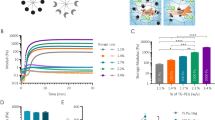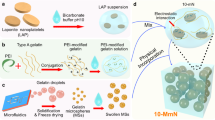Abstract
The effectiveness of stem cell therapies has been hampered by cell death and limited control over fate. These problems can be partially circumvented by using macroporous biomaterials that improve the survival of transplanted stem cells and provide molecular cues to direct cell phenotype. Stem cell behaviour can also be controlled in vitro by manipulating the elasticity of both porous and non-porous materials, yet translation to therapeutic processes in vivo remains elusive. Here, by developing injectable, void-forming hydrogels that decouple pore formation from elasticity, we show that mesenchymal stem cell (MSC) osteogenesis in vitro, and cell deployment in vitro and in vivo, can be controlled by modifying, respectively, the hydrogel’s elastic modulus or its chemistry. When the hydrogels were used to transplant MSCs, the hydrogel’s elasticity regulated bone regeneration, with optimal bone formation at 60 kPa. Our findings show that biophysical cues can be harnessed to direct therapeutic stem cell behaviours in situ.
This is a preview of subscription content, access via your institution
Access options
Subscribe to this journal
Receive 12 print issues and online access
$259.00 per year
only $21.58 per issue
Buy this article
- Purchase on Springer Link
- Instant access to full article PDF
Prices may be subject to local taxes which are calculated during checkout




Similar content being viewed by others
References
Wollert, K. C. & Drexler, H. Cell therapy for the treatment of coronary heart disease: A critical appraisal. Nature Rev. Cardiol. 7, 204–215 (2010).
Silva, E. A., Kim, E. S., Kong, H. J. & Mooney, D. J. Material-based deployment enhances efficacy of endothelial progenitor cells. Proc. Natl Acad. Sci. USA 105, 14347–14352 (2008).
Huebsch, N. & Mooney, D. J. Inspiration and application in the evolution of biomaterials. Nature 462, 426–432 (2009).
Lutolf, M. P., Gilbert, P. M. & Blau, H. M. Designing materials to direct stem-cell fate. Nature 462, 433–441 (2009).
Engler, A. J., Sen, S., Sweeny, H. L. & Discher, D. E. Matrix elasticity directs stem cell lineage specification. Cell 126, 677–689 (2006).
Huebsch, N. et al. Harnessing traction-mediated manipulation of the cell/matrix interface to control stem-cell fate. Nature Mater. 9, 518–526 (2010).
Peyton, S. R. et al. Marrow-derived stem cell motility in 3D synthetic scaffold is governed by geometry along with adhesivity and stiffness. Biotechnol. Bioeng. 108, 1181–1193 (2011).
Scadden, D. T. The stem-cell niche as an entity of action. Nature 441, 1075–1079 (2009).
Yang, F. et al. The effect of incorporating RGD adhesive peptide in polyethylene glycol diacrylate hydrogel on osteogenesis of bone marrow stromal cells. Biomaterials 26, 5991–5998 (2005).
Mammoto, A. et al. A mechanosensitive transcriptional mechanism that controls angiogenesis. Nature 457, 1103–1108 (2009).
Khetan, S. & Burdick, J. A. Patterning network structure to spatially control cellular remodeling and stem cell fate within 3-dimensional hydrogels. Biomaterials 31, 8228–8234 (2010).
Hutmacher, D. W. Scaffolds in tissue engineering bone and cartilage. Biomaterials 21, 2529–2543 (2000).
Simmons, C. A., Alsberg, E., Hsiong, S., Kim, W. J. & Mooney, D. J. Dual growth factor delivery and controlled scaffold degradation enhance in vivo bone formation by transplanted bone marrow stromal cells. Bone 35, 562–569 (2004).
Ouyang, H. W., Goh, J. C. H., Thambyah, A., Teoh, S. H. & Lee, E. H. Knitted poly-lactide-co-glycolide scaffold loaded with bone marrow stromal cells in repair and regeneration of rabbit Achilles tendon. Tissue Eng. 9, 431–439 (2003).
Madden, L. R. et al. Proangiogenic scaffolds as functional templates for cardiac tissue engineering. Proc. Natl Acad. Sci. USA 107, 15211–15216 (2010).
Stachowiak, A. N., Bershteyn, A., Tzatzalos, E. & Irvine, D. J. Bioactive hydrogels with an ordered cellular structure combine interconnected macroporosity and robust mechanical properties. Adv. Mater. 17, 399–403 (2005).
Golden, A. P. & Tien, J. Fabrication of microfluidic hydrogels using molded gelatin as a sacrificial element. Lab Chip 7, 720–725 (2007).
Wang, H. et al. Biocompatibility and osteogeneesis of biomimetic nano-hydroxyapatite/polyamide composite scaffolds for bone tissue engineering. Biomaterials 28, 3338–3348 (2007).
Lutolf, M. P. et al. Repair of bone defects using synthetic mimetics of collageneous extracellular matrices. Nature Biotechnol. 21, 513–518 (2003).
Liu Tsang, V. et al. Fabrication of 3D hepatic tissues by additive photopatterning of cellular hydrogels. FASEB J. 21, 790–801 (2007).
Prajapati, R. T., Chavally-Mis, B., Herbage, D., Eastwood, M. & Brown, R. A. Mechanical loading regulates protease production by fibroblasts in three-dimensional collagen substrates. Wound Repair Regen. 8, 226–237 (2000).
Bouhadir, K. H. et al. Degradation of partially oxidized alginate and its potential application for tissue engineering. Biotechnol. Prog. 17, 945–950 (2001).
Gibson, L. J. & Ashby, M. F. Cellular Solids (Cambridge Univ. Press, 1997).
Diduch, D. R., Coe, M. R., Joyner, C., Owen, M. E. & Balian, G. Two cell lines from bone marrow that differ in terms of collagen synthesis, osteogenic characteristics, and matrix mineralization. J. Bone Joint Surg. Am. 75, 92–105 (1993).
Hsiong, S. X., Boontheekul, T., Huebsch, N. & Mooney, D. J. Cyclic RGD peptides enhance 3D stem cell osteogenic differentiation. Tissue Eng. A 15, 263–272 (2009).
Rowley, J. A., Madlambayan, G. & Mooney, D. J. Alginate hydrogels as synthetic extracellular matrix materials. Biomaterials 20, 45–53 (1999).
Benoit, D. S., Schwartz, M. P., Durney, A. P. & Anseth, K. S. Small functional groups for controlled differentiation of hydrogel-encapsulated human mesenchymal stem cells. Nature Mater. 7, 816–823 (2008).
Khatiwala, C. B., Kim, P. D., Peyton, S. R. & Putnam, A. J. ECM compliance regulates osteogenesis by influencing MAPK signaling downstream of RhoA and ROCK. J. Bone Miner. Res. 24, 886–898 (2009).
DiMilla, P. A., Stone, J. A., Quinn, J. A., Albelda, S. M. & Lauffenburger, D. A. Maximal migration of human smooth muscle cells on fibronectin and type IV collagen occurs at an intermediate attachment strength. J. Cell Biol. 122, 729–737 (1993).
Alsberg, E., Anderson, K. W., Albeiruti, A., Rowley, J. A. & Mooney, D. J. Engineering growing tissues. Proc. Natl Acad. Sci. USA 99, 12025–12030 (2002).
Frenette, P. S., Pinho, S., Lucas, D. & Scheirerman, C. S. Mesenchymal stem cell: Keystone of the hematopoietic stem cell niche and a stepping-stone for regenerative medicine. Annu. Rev. Immunol. 31, 285–316 (2013).
Trappmann, B. et al. Extracelluar-matrix tethering regulates stem-cell fate. Nature Mater. 11, 642–649 (2012).
Gilbert, P. M. et al. Substrate elasticity regulates skeletal muscle stem cell self-renewal in culture. Science 329, 1078–1081 (2010).
Kong, H. J., Polte, T. R., Alsberg, E. & Mooney, D. J. FRET measurements of cell-traction forces and nano-scale clustering of adhesion ligands varied by substrate stiffness. Proc Natl Acad. Sci. USA 102, 4300–4305 (2005).
Khetan, S. et al. Degradation-mediated cellular traction directs stem cell fate in covalently crosslinked three-dimensional hydrogels. Nature Mater. 12, 458–465 (2013).
Yang, C., Tibbitt, M. W., Basta, L. & Anseth, K. S. Mechanical memory and dosing influence stem cell fate. Nature Mater. 13, 645–652 (2014).
Mammoto, T. et al. Mechanochemical control of mesenchymal condensation and embryonic tooth organ formation. Dev. Cell 21, 758–769 (2011).
Saha, K. et al. Substrate modulus directs neural stem cell behavior. Biophys. J. 95, 4426–4438 (2008).
Sen, S., Engler, A. & J, Discher, D. E. Matrix strains induced by cells: Computing how far cells can feel. Cell Mol. Bioeng. 2, 39–48 (2009).
Wang, Y. K. et al. Bone morphogenic protein-2 induced signaling and osteogenesis is Regulated by cell shape, RhoA/ROCK, and cytoskeletal tension. Stem Cells Dev. 21, 1176–1186 (2012).
Axelrad, T. W. & Einhorn, T. A. Bone morphogenetic proteins in orthopaedic surgery. Cytokine Growth Factor Rev. 20, 481–4882 (2009).
Platt, M. O., Wilder, C. L., Wells, A., Griffith, L. G. & Lauffenburger, D. A. Multipathway kinase signatures of multipotent stromal cells are predictive for osteogenic differentiation: Tissue-specific stem cells. Stem Cells 27, 2804–2814 (2009).
Murry, C. E. & Keller, G. Differentiation of embryonic stem cells to clinically relevant populations: Lessons from embryonic development. Cell 132, 661–680 (2008).
Groen, R. W. Y. et al. Reconstructing the human hematopoietic niche in immunodeficient mice: Opportunities for studying primary multiple myeloma. Blood 120, e9–e16 (2012).
Kong, H. J., Chan, J. H., Huebsch, N., Weitz, D. & Mooney, D. J. Noninvasive probing of the spatial organization of polymer chains in hydrogels using fluorescence resonance energy transfer (FRET). J. Am. Chem. Soc. 129, 4518–4519 (2007).
Kong, H. J., Smith, M. K. & Mooney, D. J. Designing alginate hydrogels to maintain viability of immobilized cells. Biomaterials 24, 4023–4029 (2003).
Mehta, M., Checa, S., Lienau, J., Hutmacher, D. & Duda, G. N. In vivo tracking of segmental bone defect healing reveals that callus patterning is related to early mechanical stimuli. Eur. J. Cell. Mater. 24, 358–371 (2012).
Acknowledgements
We thank S. Gunasekaran for assistance with sample cryosectioning, R. Choa for assistance with histologic analyses, and M. Brenner and V. Manoharan (Harvard University) for discussions on percolation. We thank K. Tomodo, P.-L. So and E. Hsiao (Gladstone Institute, San Francisco) for helpful discussions and editorial suggestions. We also acknowledge support from the Materials Research Science and Engineering Center (MRSEC, DMR-1420570) at Harvard University (D.J.M., X.Z., N.H.), funding from NIH (R37 DE013033), the Belgian American Educational Foundation (E.L.), an NSF Graduate Research Fellowship (N.H.), an Einstein Visiting Fellowship (D.J.M.) and funding of the Einstein Foundation Berlin through the Charité—Universitätsmedizin Berlin, Berlin-Brandenburg School for Regenerative Therapies GSC 203, the Harvard College Research Program (C.M.M., M.X.) and Harvard College PRISE, Herchel-Smith and Pechet Family Fund Fellowships (M.X.).
Author information
Authors and Affiliations
Contributions
The experiments were designed by N.H., E.L. and D.J.M. and carried out by N.H., K.L., M.M., A.M., M.C.D., R.D., S.T.K., C.V., E.L., C.M.M., M.X., O.C., W.S.K. and X.Z. New reagents and analytical tools were provided by M.M., G.N.D., K.A., A.M. and D.E.I. The manuscript was written by N.H. and D.J.M. The principal investigator is D.J.M.
Corresponding author
Ethics declarations
Competing interests
The authors declare no competing financial interests.
Supplementary information
Supplementary Information
Supplementary Information (PDF 1669 kb)
Rights and permissions
About this article
Cite this article
Huebsch, N., Lippens, E., Lee, K. et al. Matrix elasticity of void-forming hydrogels controls transplanted-stem-cell-mediated bone formation. Nature Mater 14, 1269–1277 (2015). https://doi.org/10.1038/nmat4407
Received:
Accepted:
Published:
Issue Date:
DOI: https://doi.org/10.1038/nmat4407
This article is cited by
-
Phase-separation facilitated one-step fabrication of multiscale heterogeneous two-aqueous-phase gel
Nature Communications (2023)
-
Floatable photocatalytic hydrogel nanocomposites for large-scale solar hydrogen production
Nature Nanotechnology (2023)
-
Cell–extracellular matrix mechanotransduction in 3D
Nature Reviews Molecular Cell Biology (2023)
-
The decisive early phase of bone regeneration
Nature Reviews Rheumatology (2023)
-
Hydrogel-based microenvironment engineering of haematopoietic stem cells
Cellular and Molecular Life Sciences (2023)



